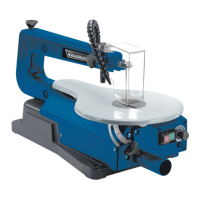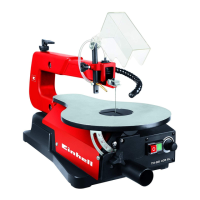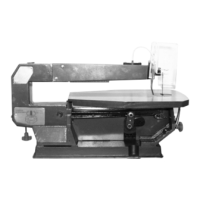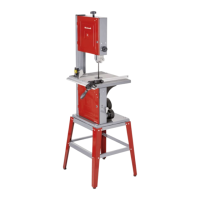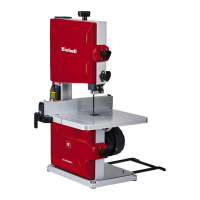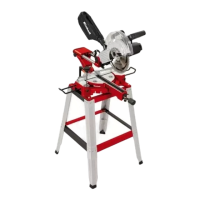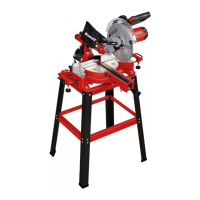1. Lung damage if no suitable protective dust mask is used.
2. Damage to hearing if no suitable ear protection is used.
Before starting the equipment
General information
All covers and safety devices have to be properly fitted before the machine is switched on.
It must be possible for the blade to run freely.
When working with wood that has been processed before, watch out for foreign bodies such as nails or screws
etc.
Before you actuate the On/Off switch, make sure that the saw blade is correctly fitted and that the machine’s
moving parts run smoothly.
Before you connect the machine to the power supply, make sure the data on the rating plate is the same as that
for your mains.
Assembly
Caution: Pull out the power plug before carrying out any maintenance and conversion work on your fretsaw.
For greater stability, fasten the equipment in addition to a workbench or similar (Fig. 8). Suitable fastening materials
such as screws etc. are available from your dealer.
Mounting the saw blade guard and the sawdust blower facility (Fig. 4/5)
Fasten the retaining pin and the saw blade guard to the arm (19) as shown in Fig. 4.
The saw blade guard can be fixed at various heights with the clamping screw (11).
Mount the blow-off device (16) as shown in Fig. 6. 5.2.2 Changing the blade (Fig. 1/3/6a)
Turn the clamp lever (14) counterclockwise to release the saw blade (15).
Unscrew the left cover (4).
First take the blade out of the top blade holder (13), pressing down the upper pendulum arm as you do so.
Then take the blade out of the bottom blade holder (8).
Pull the blade up and out through the table insert (18).
Install the new blade in reverse order.
Use the supplied Hexagon key (24) to clampfit the saw blade in the holder
Caution: Always insert the blade so that the teeth point toward the saw table.
Turn the clamp lever (14) clockwise to clamp the saw blade.
Tilting the saw table (Fig. 7)
Undo the locking screw (5).
Tilt the table (7) to the left until the indicator (17) points to the required angle value on the scale (6).
Important: For precision work you should first carry out a trial cut and then re-adjust the tilt angle as required.
Clamp-fitting a coping saw blade (Fig. 6b-6c)
Many commercially available coping saw blades can also be used with this machine.
Remove the saw blade as described in 5.2.2
Pass the coping saw blade down through the table insert (18) and into the bottom holder (8)
Use the supplied Hexagon key (24) to clampfit the saw blade in the holder
Insert the saw blade into the top holder (13) and clamp-fit with the supplied Hexagon key
Turn the clamp lever (14) clockwise to clamp the saw blade
Operation
Please note:
Your saw does not cut wood automatically.

